Why we need digital technologies for architectural conservation
Digital, Skills | Written by: Yueqian Wang | Thursday 20 March 2025
Digital technologies are vital for architectural conservation. Our former Digital Innovation Trainee Yueqian Wang headed to Venice for the Comité International de Formation (CIF) to discover incredible projects using digital technologies for heritage.
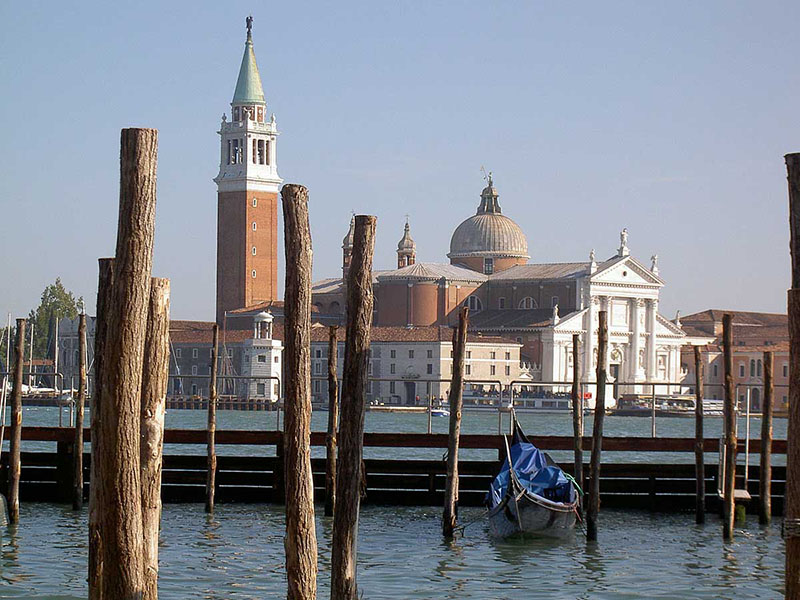
Venice was a major maritime power during the Middle Ages and Renaissance, and a centre of commerce and art in the 13th century up to the end of the 17th century. © Robert Gordon University. Licensor www.scran.ac.uk.
Built heritage conservation projects require experts and professionals from different disciplines and with diverse skills.
In amongst a rich offer of workshops and lectures at CIF, I found several activities within my own area of interest regarding capturing digital heritage.
I had the chance to meet and talk to heritage conservation professionals and experts at different stages of their careers. Their wisdom, insights and unchanged passion for heritage are meaningful to me.
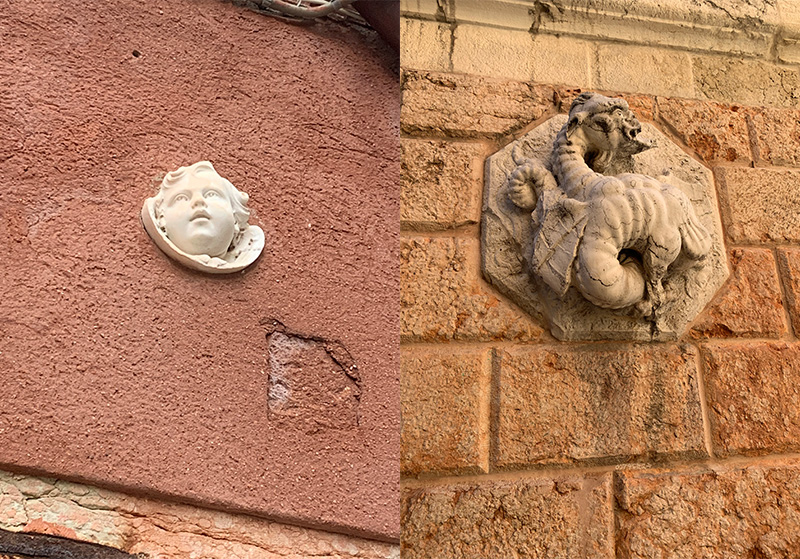
Architectural decoration in Venice, a unique type of built heritage. Copyright Yueqian Wang.
During our visit to the Doge’s Palace, I found that digital technologies, especially 3D technologies, are being widely applied in practical conservation projects. These can be used to support the restoration of a single building or inform the decision-making of the conservation of an urban area.
Read on to learn more about the digital technologies supporting architectural conservation.
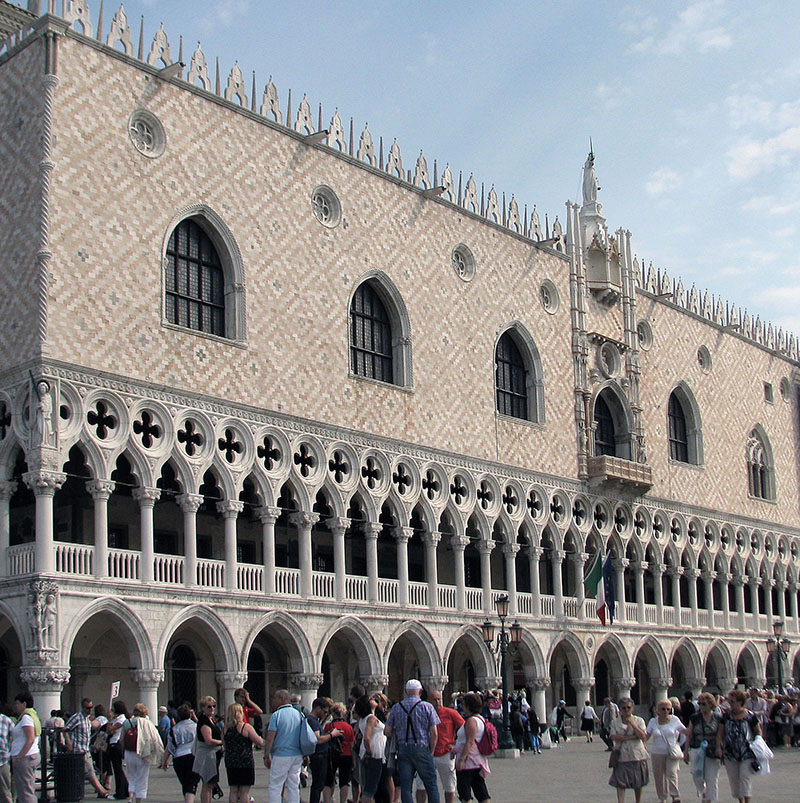
The Doge’s Palace, bordering St Mark’s Square, Venice (Piazza San Marco). © Cairns Aitken. Licensor www.scran.ac.uk.
3D technologies can help us better understand the condition of structures
I witnessed the conservation work in the Room of the Four Doors at Doge’s Palace, a project focussing on the richly decorated vaulted ceiling.
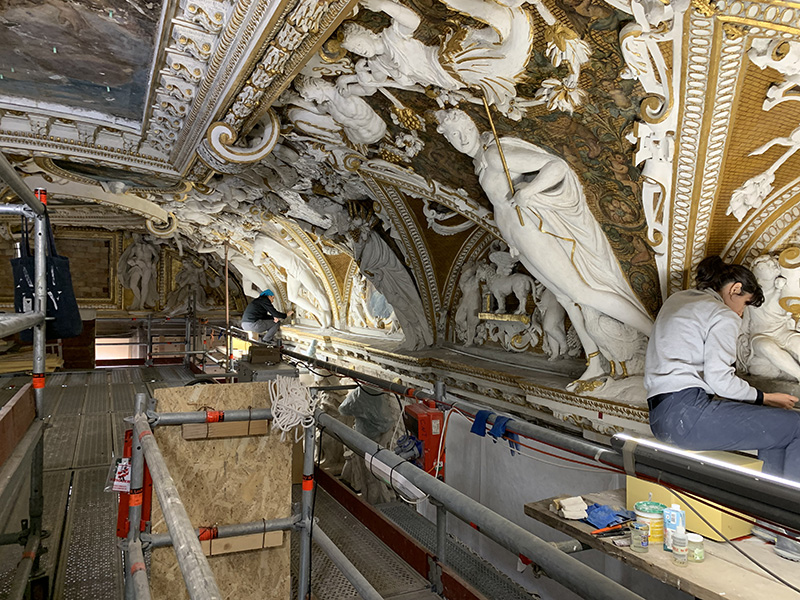
Conservators working on the ceiling of the Room of the Four Doors at Doge’s Palace. Copyright Yueqian Wang.
During their condition survey and analysis, the project team completed a measured building survey and 3D laser scanning of the timber roof to aid the understanding of the structural integrity of the ceiling, alongside historic drawings. By using digital survey, the engineers were able to create an analytical model of the roof frames and identify the areas that needed consolidation in greater detail.
The areas required to be reinforced are mapped meticulously and six types of consolidation units were designed to address the issues in different areas. On our visit, the consolidation rods were being put in. The conservators were also working on cleaning and repairing the painting, stucco and stone. The material and techniques used for interventions are fully reversible in the future. This is done so that the intervention is not confused with the original ceiling, and will not leave a permanent impact on the historic building.
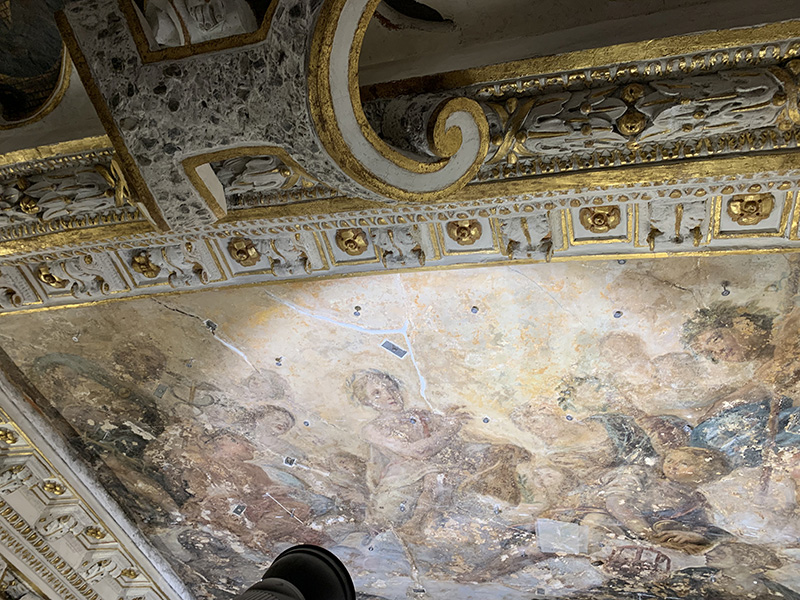
Ceiling reinforced with rods at the Room of the Four Doors at Doge’s Palace. Copyright Yueqian Wang.
Due to the ongoing conservation treatment, a scaffold provides access to the ceiling and the room is closed to the public. A virtual tour using 360 footage was used to provide access for the public while the ceiling was under repair.
Similar to these efforts, during my collaborative project with the National Trust for Scotland, I led on documenting six historic plaster ceilings at Kellie Castle. The project is using data to better understand the condition of the ceilings.
3D technology can capture heritage on a big scale and facilitate research in a wider context
A great example of this is Venice’s MOSE system. The system is made up of 3 movable dams designed to protect Venice’s built heritage from floods.
When I visited the office of Venice World Sustainability Capital Foundation for a presentation on the research, I was shown how information on the city of Venice and surrounding areas were collected to inform the decision-making of this grand engineering project.
The whole city of Venice was scanned before the construction of the dams. It is the first city in the world to be fully recorded in 3D. Having a comprehensive digital record is beneficial for the study of Venice and for the conservation of the built heritage, which is under the threat from impacts of climate change. Not only the architecture but the decorative sculptures in Venice are of high artistic value and are recorded in the 3D model.
A 3D digital model was also developed to study the land-water system of the lagoon. Topographical data (data showing the lay of the land) collected by UAV (unmanned aerial vehicle) and MBES (multibeam echosounder) of the surrounding landscape and seabed were also collected to study the changes and erosion of the shores. The use of 3D digital data in collaboration with other research, facilitated the understanding of the possible impacts on both the built and natural environment.
The impact of climate change on archaeological and historic sites is increasingly becoming a source of concern in the cultural heritage sector.
At HES, as part of the Rae Project, we 3D survey the sea wall at Skara Brae in Orkney every two years to monitor coastal erosion by comparing different datasets captured over time. This feeds into the Dynamic Coast project.
3D datasets can be used for decision-making and research
From my observations in Venice, most 3D datasets were collected and used to inform and facilitate decision-making of intervention, while examples of 3D technologies used for archival or interpretation purposes were fewer. For example, at Doge’s Palace the 3D model of the roof structures assisted the architects and engineers to gain more insights on the structural integrity and apply more sympathetic approaches in designing the reinforcement units. Specific 3D technologies, like 3D laser scanning and photogrammetry, were widely used as a part of non-destructive testing tools to address targeted research questions, while 3D modelling, 3D printing and VR were less involved in conservation projects.
Our Sketchfab model of the Sceptre, part of the Honours of Scotland. This is an example of High Renaissance Italian artistry. This 3D model was used as a reference and tool for metal conservators to make informed decisions about the care and conservation of this precious artefact.
Digital datasets can enhance heritage experience
There is great potential to reuse and process the existing 3D datasets for educational or interpretation purposes, improving accessibility. This can further enhance the understanding of conservation projects for experts and for public audiences whilst also promoting the heritage site more widely.
Find out more
Find out more about our Digital Documentation and Innovation teams and explore 3D models of our objects and collections on Sketchfab.
About the author:
Yueqian Wang
Yueqian Wang was a Digital Innovation Trainee at the Engine Shed, working jointly with Historic Environment Scotland's Digital Documentation and Innovation team and the National Trust for Scotland. She graduated in Architectural Conservation from the University of Edinburgh. Her traineeship explored the ways digital documentation can be innovatively applied to the heritage sector as a tool for site management, accessibility, monitoring, and more.
View all posts by Yueqian Wang



